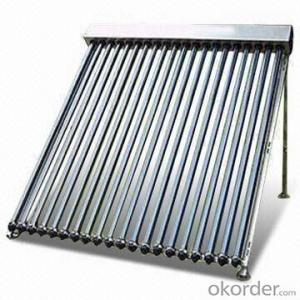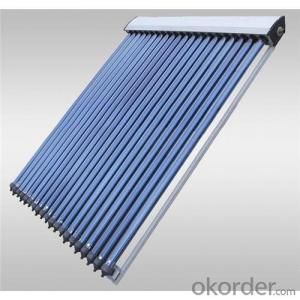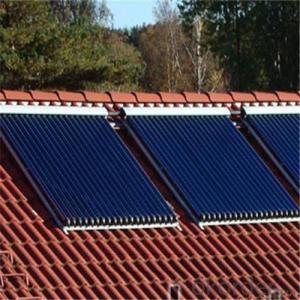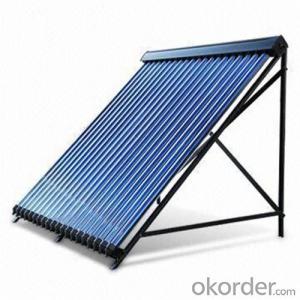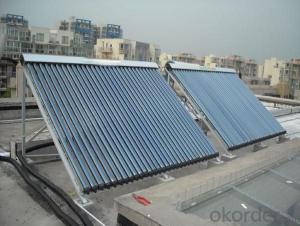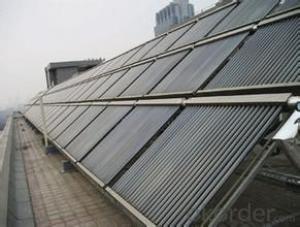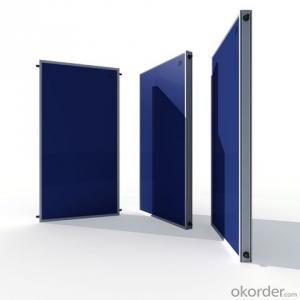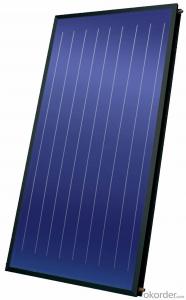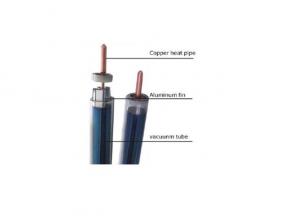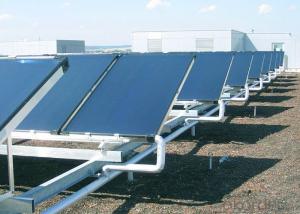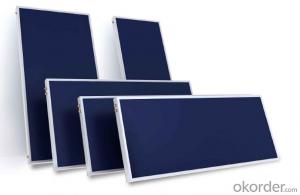Vacuum Tube Solar Collectors for Rooftop
- Loading Port:
- China main port
- Payment Terms:
- TT OR LC
- Min Order Qty:
- 5 set
- Supply Capability:
- 10000 set/month
OKorder Service Pledge
OKorder Financial Service
You Might Also Like
Specifications
manifold (inner) | red copper |
manifold (exterior) | aluminum alloy |
glass tube dimensions | 58mm * 1800mm |
daily efficiency | ≥55% |
heat preservation | 72 hours |
hail resistance | 25mm |
max pressure | 7 bar |
coating of vacuum tube | ALN/AIN-SS/CU |
heat pipe | anti-freezing > -35 degree |
certificate | Solar Keymark, EN12975,SRCC |
Serious Product
Models | L*W*H mm | Vacuum tube | Power output | Efficiency | Header mm | Frame | container loading 20FT/40HQ sets | Gross Weight kg |
SHC-8 | 1917*910*133 | 58*1800*8pcs | 939W | 0.668 | Φ35/1.0 | AL alloy | 185/445 | 27 |
SHC-10 | 1917*1130*133 | 58*1800*10pcs | 1189W | 159/385 | 33 | |||
SHC-12 | 1917*1350*133 | 58*1800*12pcs | 1440W | 149/358 | 40 | |||
SHC-15 | 1917*1680*133 | 58*1800*15pcs | 1815W | 120/290 | 49 | |||
SHC-18 | 1917*2010*133 | 58*1800*18pcs | 2191W | 100/242 | 59 | |||
SHC-20 | 1917*2230*133 | 58*1800*20pcs | 2442W | 87/210 | 66 | |||
SHC-22 | 1917*2450*133 | 58*1800*22pcs | 2692W | 83/202 | 72 | |||
SHC-24 | 1917*2670*133 | 58*1800*24pcs | 2943W | 77/188 | 79 |
Packaging & Delivery
Packaging Details: | Exporting Carton with big foaming protection |
Delivery Detail: | In 10-15 days |
Loading Quantity
Model | Tube | Tube Q.T.Y | Loading Q.T.Y/40HQ |
GSC15 | 58*1800mm | 15pcs | 315sets |
GSC18 | 58*1800mm | 18pcs | 265sets |
GSC20 | 58*1800mm | 20pcs | 248sets |
GSC22 | 58*1800mm | 22pcs | 225sets |
GSC25 | 58*1800mm | 25pcs | 200sets |
GSC30 | 58*1800mm | 30pcs | 168sets |
Principle of solar collector:
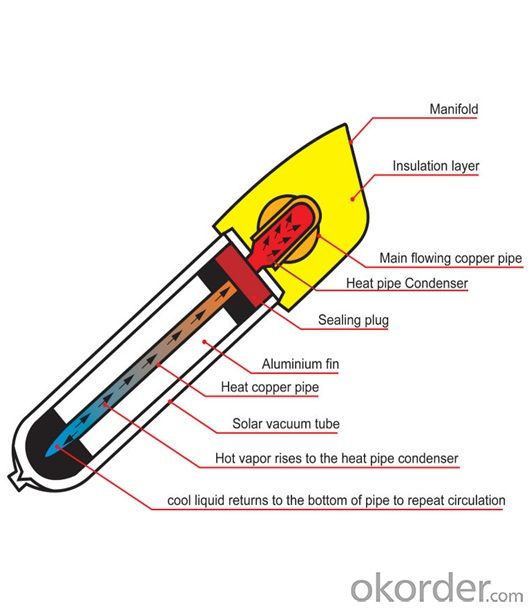

Solar collector details
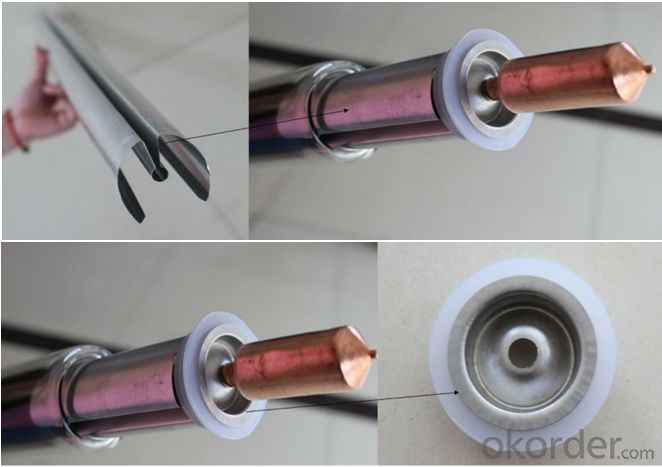

- Q:How do solar collectors impact local economies?
- Solar collectors have a significant impact on local economies in several ways. Firstly, the installation and maintenance of solar collectors create job opportunities within the community. These jobs range from sales and marketing to installation and maintenance technicians. As the solar industry continues to grow, so does the demand for skilled workers, resulting in a boost in employment rates and income levels. Moreover, solar collectors help reduce energy costs for both residential and commercial properties. By harnessing the sun's energy, individuals and businesses can generate their own electricity, leading to substantial savings on utility bills. This increased disposable income can then be reinvested into the local economy, stimulating growth and supporting other businesses within the community. In addition, the use of solar collectors reduces dependence on fossil fuels, which in turn decreases the demand for imported energy sources. This shift towards renewable energy contributes to energy independence, reducing the vulnerability to price fluctuations and supply disruptions. Consequently, local economies become more resilient and stable, as the money that would have been spent on imported energy can now be circulated within the community. Furthermore, the installation of solar collectors can increase property values. Studies have shown that homes equipped with solar panels tend to sell at a premium compared to those without. This value appreciation positively impacts homeowners, as they can potentially sell their properties at higher prices, leading to increased wealth and economic stability within the community. Lastly, solar collectors promote the development of local industries and businesses. With the increased demand for solar technology, local manufacturers, suppliers, and retailers have the opportunity to expand and thrive. This growth creates a ripple effect, generating additional employment opportunities and fostering innovation within the region. In conclusion, solar collectors have a positive impact on local economies by creating jobs, reducing energy costs, promoting energy independence, increasing property values, and fostering the growth of local industries. As communities transition towards renewable energy sources, they not only benefit from a cleaner and more sustainable environment but also experience economic growth and prosperity.
- Q:Are there any limitations to the angle of installation for solar collectors?
- Yes, there are limitations to the angle of installation for solar collectors. The optimal angle for solar collectors depends on the latitude of the installation location and the time of year. In general, solar collectors should be installed at an angle that maximizes the amount of sunlight they receive throughout the year. In locations closer to the equator, where the sun is higher in the sky year-round, solar collectors are typically installed at a steeper angle, usually around 30 to 40 degrees. This allows for maximum solar radiation absorption throughout the day. In areas farther from the equator, where the sun's angle changes significantly throughout the year, solar collectors are often installed at a shallower angle. This helps to optimize solar energy absorption during the winter months when the sun is lower in the sky. However, there are limitations to the angle of installation. If the angle is too steep or too shallow, it can result in reduced energy production. Steeper angles may cause snow or debris to accumulate on the solar panels, hindering their efficiency. Shallower angles may result in less solar radiation absorption, especially during the winter months. Other factors that may limit the angle of installation include space constraints, structural limitations, and aesthetic considerations. In some cases, the angle of installation may need to be adjusted to accommodate these factors, even if it is not optimal for maximum energy production. Overall, while there are limitations to the angle of installation for solar collectors, careful consideration of the location, time of year, and other factors can help ensure maximum energy production and efficiency.
- Q:Can solar collectors be used for heating food in commercial kitchens?
- Yes, solar collectors can be used for heating food in commercial kitchens. Solar collectors, such as solar thermal panels or parabolic troughs, can efficiently capture and convert solar energy into heat. This heat can then be used to power various cooking appliances in a commercial kitchen, including ovens, stoves, and grills. By harnessing the power of the sun, commercial kitchens can reduce their reliance on fossil fuels and traditional energy sources, leading to cost savings and environmental benefits. Solar collectors can provide a renewable and sustainable solution for heating food, especially in regions with abundant sunlight. However, it is important to note that the implementation of solar collectors for commercial kitchens might require careful planning and consideration. Factors such as the availability of sunlight, the size and capacity of the solar collectors, and the energy demands of the kitchen need to be taken into account to ensure the system meets the required heating requirements. Moreover, solar collectors might not be suitable for all food preparation processes in a commercial kitchen. They are better suited for tasks that require lower or moderate heat, such as simmering, boiling, or slow cooking. For high-temperature cooking methods like frying or searing, additional conventional heat sources may still be necessary. In conclusion, solar collectors can indeed be used for heating food in commercial kitchens, offering a sustainable and renewable alternative to traditional energy sources. However, careful planning and consideration of specific needs and requirements are essential to ensure the successful integration of solar heating systems in commercial kitchen operations.
- Q:Can solar collectors be used in conservation areas?
- Yes, solar collectors can be used in conservation areas. However, it is important to ensure that the installation of solar collectors does not disrupt the natural ecosystem or harm any wildlife. Careful planning and consideration of the specific conservation area's guidelines and regulations may be necessary to determine the appropriate placement and design of solar collectors in order to minimize any potential negative impact on the environment.
- Q:Can solar collectors be used for electricity generation?
- Yes, solar collectors can be used for electricity generation. They convert sunlight into electricity through photovoltaic cells, also known as solar panels. These panels harness the sun's energy and convert it into usable electricity, making solar collectors an effective and sustainable method for generating electricity.
- Q:How much space is required to install solar collectors?
- The space required to install solar collectors depends on various factors such as the size and type of collectors, the energy needs of the system, and the available sunlight. Generally, solar collectors can be installed on rooftops, open land areas, or even integrated into building designs. It is recommended to consult with a solar professional to assess the specific space requirements for a particular installation.
- Q:How do solar collectors perform in extreme weather conditions?
- Solar collectors are designed to withstand extreme weather conditions. They are built with durable materials that can resist harsh temperatures, strong winds, and heavy snowfall. Additionally, their design allows for self-cleaning and efficient heat transfer, ensuring optimal performance even in adverse weather conditions.
- Q:Can solar collectors be used in incineration plants?
- Yes, solar collectors can be used in incineration plants. They can be employed to generate electricity or provide heat for various processes within the plant, thereby reducing the reliance on conventional energy sources and enhancing the overall efficiency and sustainability of the facility.
- Q:Can solar collectors be used in steel mills?
- Solar collectors have the potential to be employed in steel mills. Options like solar thermal systems or photovoltaic panels can be utilized in steel mills to generate electricity or heat energy for different industrial purposes. By harnessing the power of sunlight and converting it into usable energy, these collectors can reduce reliance on fossil fuels and decrease greenhouse gas emissions. In steel mills, solar collectors can be integrated into the existing infrastructure to provide renewable energy for various processes, including powering machinery, heating water, or driving specific stages of the steel production process. Moreover, the implementation of solar collectors in steel mills can lead to reduced operational costs and enhanced sustainability within the steel production industry.
- Q:Can solar collectors be used in residential homes?
- Yes, solar collectors can be used in residential homes. They are often installed on rooftops to capture sunlight and convert it into usable energy for heating water, powering appliances, and providing electricity. Solar collectors are a sustainable and cost-effective way to reduce reliance on traditional energy sources and decrease carbon emissions in residential settings.
1. Manufacturer Overview |
|
|---|---|
| Location | |
| Year Established | |
| Annual Output Value | |
| Main Markets | |
| Company Certifications | |
2. Manufacturer Certificates |
|
|---|---|
| a) Certification Name | |
| Range | |
| Reference | |
| Validity Period | |
3. Manufacturer Capability |
|
|---|---|
| a)Trade Capacity | |
| Nearest Port | |
| Export Percentage | |
| No.of Employees in Trade Department | |
| Language Spoken: | |
| b)Factory Information | |
| Factory Size: | |
| No. of Production Lines | |
| Contract Manufacturing | |
| Product Price Range | |
Send your message to us
Vacuum Tube Solar Collectors for Rooftop
- Loading Port:
- China main port
- Payment Terms:
- TT OR LC
- Min Order Qty:
- 5 set
- Supply Capability:
- 10000 set/month
OKorder Service Pledge
OKorder Financial Service
Similar products
New products
Hot products
Hot Searches
Related keywords
